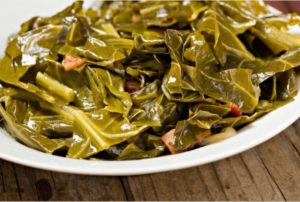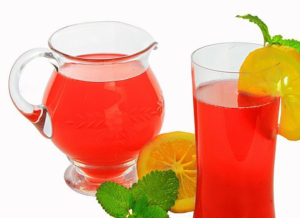As the year ends and a new one is beginning, many families enjoy a big feast to celebrate the achievements of the previous year and welcome the opportunities of the one to start. Here are a few items to consider for your end of year feast this New Year.

In the book Soul Food: The Surprising Story of an American Cuisine One Plate at a Time, Adrian Miller explains that during the Down Home Cooking era of the 1890s to the 1970s, chitlins reminded Southern migrants of how good times were had at hog killings in the rural South. Rural blacks came together for these hog killings, performed the work of preparing for the event, then divided the rewards.
Makes 12 Servings
Ingredients
- 20 pounds fresh or thawed chitlins, cut into 6-inch lengths
- 1 large onion, coarsely chopped
- 4 garlic cloves, chopped
- ¼ cup crushed red pepper
- Hot sauce, coleslaw, ad meatless spaghetti, for serving
Directions
- Bring a very large pot of water to a boil. Drain the chitlins and transfer them into the boiling water and let cook for 5 minutes. This step helps kill germs and does not interfere with cleaning the chitlins.
- Drain the chitlins in a colander, pour them into a clean sink or very large bowl, and cover them with fresh, cold water. (Ig the chitlings came in buckets, use one of them to hold the parts that will be discarded.) Refill the large pot with cold water to hold the chitlins after they are cleaned.
- To clean each strip of chitlins, use your fingers to separate the thin, transparent membrane from the rough part. (This is like pulling the top piece of tape from double-sided tape.) Rinse the membrane under cold running water until it is free of debris and dirty fat, but leave any clean fat. Drop the cleaned part into the pot and discard the rest.
- Drain the pot of cleaned chitlins and cover them with fresh cold water. Repeat the draining and rinsing process until the water is no longer cloudy.
- Bring to a simmer over medium-low heat. Simmer for 1 hour. Drain the chitlins, return them to the pot, and cover with fresh water. Add the onion, garlic, and pepper flakes. Simmer until the chitlins are very tender and a little shiny from the grease, about 2 hours more. They will look like long, gray-brown thick noodles.
- Remove the chitlins from the pot with tongs and divide among serving plates. Serve hot with hot sauce, coleslaw, and spaghetti with a meatless tomato sauce.

According to one theory offered in Soul Food, the superstition behind eating Black-Eyed Peas on New Year’s Day came from German folklore. When the clock announces the new year, you should eat plenty of lentils, pork, white cabbage, and potato dumplings so the new year will bring you good luck and lots of money.
The South had a number of German immigrants who were slaveholders in the antebellum era. Miller suggests enslaved African Americans likely prepared traditional New Year’s Day meals for their German masters. The theory proposes that they borrowed the folklore, gave it an African American spin by substituting in their own foods, and passed it along from the Big House to the slave quarters.
Makes 8 servings
Ingredients
- 1 pound dried black-eyed or other field peas
- 1 smoked ham hock or smoked turkey wing (about 8 ounces)
- 1 medium onion, chopped
- Crushed red pepper flakes, to taste
- Salt, to taste
Directions
- Rinse the peas and pick through them to discard any small stones or broken peas. Pour the peas into a large saucepan and cover with cold water by 2 inches. Bring them to a boil and cook for 5 minutes. Remove the pot from the heat, cover, and let stand for 1 hour. (Alternatively, plae the peas in a large bowl, cover with cold water, and let stand at room temperature overnight.)
- Meanwhile, make a stock by placing the ham hock or turkey wing in another large saucepan. Cover with water by 2 inches. Bring to a boil, reduce the heat, and simmer until the stock is flavorful, about 1 hour. Remove the hock or wing.
- Drain the soaking liquid from the peas and add them to the stock. Make sure the peas are submerged. Stir in the onion and pepper flakes.
- Simmer until the peas are nearly tender, about 39 minutes. Season with salt and continue simmering until the peas are tender and well seasoned, about 10 minutes more.
- Serve the peas warm.
- If desired, you may pull meat off the ham hock or turkey wing and add it to the dish before serving

In Soul Food: The Surprising Story of an American Cuisine One Plate at a Time, Adrian Miller cites an American slave narrative that recounts children being fed only the pot likker or broth from cooked greens and other vegetables. The adults would have the greens; children would be given wooden spoons to scoop out the pot likker from large troughs. Today, nutritionists claim that the best part of a greens dish is the broth. It contains all the vitamins and nutrients drained out of the greens during the stewing process.
Makes 8 servings
Ingredients
- 2 smoked ham hocks or smoked turkey wings, or 1 leg (1 pound)
- 1½ pounds turnip greens
- 1½ pounds mustard greens
- 1 tablespoon granulated garlic or 2 minced garlic cloves
- 1 medium onion, chopped
- Pinch of crushed red pepper flakes
- Pinch of baking soda
- Pinch of sugar
- Pinch of salt
Directions
- Rinse the hocks, wings, or leg, place them in a large pot, and cover with water. Bring to a boil and cook until the meat is tender and the cooking liquid is flavorful, 20 to 30 minutes. Discard the hocks, wings, or legs.
- Meanwhile, remove and discard the tough stems from the grens. Cut or tear the leaves into large, bite-sized pieces. Fill a clean sink or very large bowl with cold water. Add the leaves and gently swish them in the water to remove any dirt or grit. Lift the leaves out of the water and add them to the hot stock, stirring gently until they wilt and are submerged.
- Stir in the onion, pepper flakes, baking soda, suar, and salt.
- Simmer until the greens are tender, about 30 minutes. Check the seasoning and serve hot.

According to Soul Food, Kool-Aid became an important factor of military life for black troops serving in the Vietnam War. Many of the service personnel in Vietnam who often felt vulnerable and alone needed a tangible connection with life in the United States, so they would request red Kool-Aid packages to be sent in care packages.
Miller notices a shift in the consumption of Kool-Aid lately, though. He explains that many young people prefer grape Kool-Aid. Here is a recipe that seeks to bridge the generational gap by mixing red and grape Kool-Aid together.
Makes 4 to 6 quarts
Ingredients
- 1 envelope cherry Kool-Aid
- 1 envelope tropical punch Kool-Aid
- 1 envelope grape Kool-Aid
- 4 cups sugar, or to taste
- 4 to 6 quarts water
- Lemon slices, for serving (optional)
Directions
- Empty the Kool-Aid envelopes into a very large pitcher. Add the sugar Pour in water until the mixture is as sweet and concentrated as you like. Stir until the sugar dissolves. Refrigerate until chilled.
- Serve over ice with a slice of lemon if you wish.





